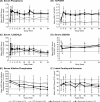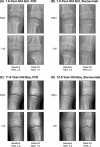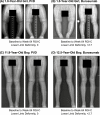Effect of Burosumab Compared With Conventional Therapy on Younger vs Older Children With X-linked Hypophosphatemia
- PMID: 35533340
- PMCID: PMC9282253
- DOI: 10.1210/clinem/dgac296
Effect of Burosumab Compared With Conventional Therapy on Younger vs Older Children With X-linked Hypophosphatemia
Abstract
Context: Younger age at treatment onset with conventional therapy (phosphate salts and active vitamin D; Pi/D) is associated with improved growth and skeletal outcomes in children with X-linked hypophosphatemia (XLH). The effect of age on burosumab efficacy and safety in XLH is unknown.
Objective: This work aimed to explore the efficacy and safety of burosumab vs Pi/D in younger (< 5 years) and older (5-12 years) children with XLH.
Methods: This post hoc analysis of a 64-week, open-label, randomized controlled study took place at 16 academic centers. Sixty-one children aged 1 to 12 years with XLH (younger, n = 26; older, n = 35) participated. Children received burosumab starting at 0.8 mg/kg every 2 weeks (younger, n = 14; older, n = 15) or continued Pi/D individually titrated per recommended guidelines (younger, n = 12; older, n = 20). The main outcome measure included the least squares means difference (LSMD) in Radiographic Global Impression of Change (RGI-C) rickets total score from baseline to week 64.
Results: The LSMD in outcomes through 64 weeks on burosumab vs conventional therapy by age group were as follows: RGI-C rickets total score (younger, +0.90; older, +1.07), total Rickets Severity Score (younger, -0.86; older, -1.44), RGI-C lower limb deformity score (younger, +1.02; older, +0.91), recumbent length or standing height Z-score (younger, +0.20; older, +0.09), and serum alkaline phosphatase (ALP) (younger, -31.15% of upper normal limit [ULN]; older, -52.11% of ULN). On burosumab, dental abscesses were not reported in younger children but were in 53% of older children.
Conclusion: Burosumab appears to improve outcomes both in younger and older children with XLH, including rickets, lower limb deformities, growth, and ALP, compared with Pi/D.
Trial registration: ClinicalTrials.gov NCT02915705.
Keywords: X-linked hypophosphatemia; burosumab; children; fibroblast growth factor 23; rickets.
© The Author(s) 2022. Published by Oxford University Press on behalf of the Endocrine Society.
Figures




Similar articles
-
Burosumab vs Phosphate/Active Vitamin D in Pediatric X-Linked Hypophosphatemia: A Subgroup Analysis by Dose Level.J Clin Endocrinol Metab. 2023 Oct 18;108(11):2990-2998. doi: 10.1210/clinem/dgad230. J Clin Endocrinol Metab. 2023. PMID: 37084401 Free PMC article.
-
Safety and efficacy of burosumab in improving phosphate metabolism, bone health, and quality of life in adolescents with X-linked hypophosphatemic rickets.Eur J Med Genet. 2024 Aug;70:104958. doi: 10.1016/j.ejmg.2024.104958. Epub 2024 Jun 29. Eur J Med Genet. 2024. PMID: 38950880
-
Efficacy and safety of burosumab in children aged 1-4 years with X-linked hypophosphataemia: a multicentre, open-label, phase 2 trial.Lancet Diabetes Endocrinol. 2019 Mar;7(3):189-199. doi: 10.1016/S2213-8587(18)30338-3. Epub 2019 Jan 9. Lancet Diabetes Endocrinol. 2019. PMID: 30638856 Clinical Trial.
-
Burosumab for Pediatric X-Linked Hypophosphatemia.Curr Osteoporos Rep. 2021 Jun;19(3):271-277. doi: 10.1007/s11914-021-00669-9. Epub 2021 May 10. Curr Osteoporos Rep. 2021. PMID: 33970403 Free PMC article. Review.
-
Systematic Review: Efficacy of Medical Therapy on Outcomes Important to Pediatric Patients With X-Linked Hypophosphatemia.J Clin Endocrinol Metab. 2025 Apr 22;110(5):1205-1217. doi: 10.1210/clinem/dgaf011. J Clin Endocrinol Metab. 2025. PMID: 39787354 Free PMC article.
Cited by
-
Alkaline phosphatase in clinical practice in childhood: Focus on rickets.Front Endocrinol (Lausanne). 2023 Feb 2;14:1111445. doi: 10.3389/fendo.2023.1111445. eCollection 2023. Front Endocrinol (Lausanne). 2023. PMID: 36817604 Free PMC article. Review.
-
Diagnosis, treatment, and management of rickets: a position statement from the Bone and Mineral Metabolism Group of the Italian Society of Pediatric Endocrinology and Diabetology.Front Endocrinol (Lausanne). 2024 Apr 19;15:1383681. doi: 10.3389/fendo.2024.1383681. eCollection 2024. Front Endocrinol (Lausanne). 2024. PMID: 38706696 Free PMC article. Review.
-
Experts' consensus on the management and treatment of individuals with X-linked hypophosphatemia across lifespan.J Endocrinol Invest. 2025 Jul 1. doi: 10.1007/s40618-025-02611-7. Online ahead of print. J Endocrinol Invest. 2025. PMID: 40591205
-
Burosumab for X-linked hypophosphatemia in children and adolescents: Opinion based on early experience in seven European countries.Front Endocrinol (Lausanne). 2023 Jan 31;13:1034580. doi: 10.3389/fendo.2022.1034580. eCollection 2022. Front Endocrinol (Lausanne). 2023. PMID: 36798486 Free PMC article. Review.
-
Burosumab vs conventional therapy in children with X-linked hypophosphatemia: results of the open-label, phase 3 extension period.JBMR Plus. 2024 Jan 4;8(1):ziad001. doi: 10.1093/jbmrpl/ziad001. eCollection 2024 Jan. JBMR Plus. 2024. PMID: 38690124 Free PMC article. Clinical Trial.
References
Publication types
MeSH terms
Substances
Associated data
Grants and funding
LinkOut - more resources
Full Text Sources
Medical
Research Materials
Miscellaneous

